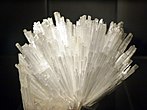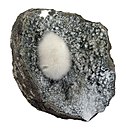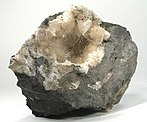Mesolite
(same H-M symbol)
b = 56.655(6) Å,
c = 6.5443(4) Å; Z = 8
Mesolite is a tectosilicate mineral with formula Na2Ca2(Al2Si3O10)3·8H2O. It is a member of the zeolite group and is closely related to natrolite which it also resembles in appearance.
Mesolite crystallizes in the orthorhombic system and typically forms fibrous, acicular prismatic crystals or masses.[3] Radiating sprays of needlelike crystals are not uncommon. It is vitreous in luster and clear to white in color. It has a Mohs hardness of 5 to 5.5 and a low specific gravity of 2.2 to 2.4. The refractive indices are nα=1.505 nβ=1.505 nγ=1.506.
Occurrence
It was first described in 1816 for an occurrence in the Cyclopean Islands near Catania, Sicily.[5] From the Greek mesos, "middle", as its composition lies between natrolite and scolecite.[4][5] Like other zeolites, mesolite occurs as void fillings in amygdaloidal basalt also in andesites and hydrothermal veins.[3]
Images
-
 Mesolite
Mesolite -
 "Puff ball" of mesolite in a basaltic vug
"Puff ball" of mesolite in a basaltic vug -
 Mesolite often forms in fibrous crystals
Mesolite often forms in fibrous crystals -
 A pocket of hairlike acicular crystals of mesolite growing off thomsonite
A pocket of hairlike acicular crystals of mesolite growing off thomsonite -
 Fibrous crystal sample retrieved from caverns near Pune, India
Fibrous crystal sample retrieved from caverns near Pune, India
References
- Mineral Galleries
- v
- t
- e
















